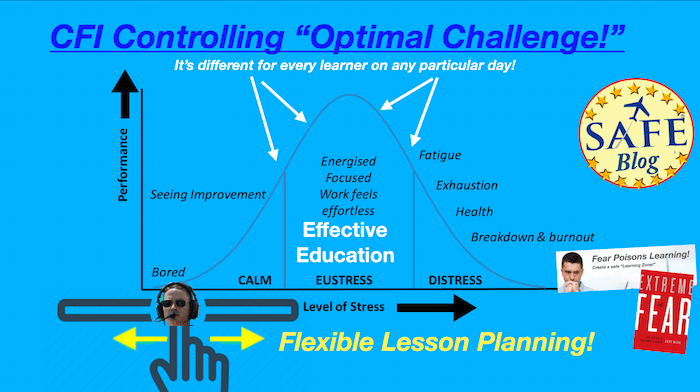
 Last week we discussed the critical CFI magic of assessing your learner’s abilities on lesson day. To present the optimal challenge we must precisely challenge the learner’s abilities when they show up to fly. This requires keen discernment and empathy – remember when *you* were struggling to climb this seemingly impossible “learning ladder.” The pre and post-brief are where real education happens at the higher levels – no airplane distraction and fear of sudden death🙀. In flight, the learner’s brain is 90% full just managing the flight – until habits and muscle memory take over (the magic of learning). We can only transmit very small precise corrections.
Last week we discussed the critical CFI magic of assessing your learner’s abilities on lesson day. To present the optimal challenge we must precisely challenge the learner’s abilities when they show up to fly. This requires keen discernment and empathy – remember when *you* were struggling to climb this seemingly impossible “learning ladder.” The pre and post-brief are where real education happens at the higher levels – no airplane distraction and fear of sudden death🙀. In flight, the learner’s brain is 90% full just managing the flight – until habits and muscle memory take over (the magic of learning). We can only transmit very small precise corrections.
 You may also discover once the flight is in motion, your learner is rustier than you thought, more distracted, or scared – all of which diminish their brain capacity. This capacity will also vary throughout a lesson with fatigue. A savvy CFI needs to be flexible and adjust as necessary to avoid overwhelming the learner. A common error here is sticking with the planned/assigned lesson. Instead, “dial down” the learner challenge as necessary. And fight the urge to chatter continuously. This is a habit every new CFI has to learn to control. During busy operations, I take a note on my phone for later discussion – during a less busy time or in the debrief. Feedback is useless when your learner is fully occupied.
You may also discover once the flight is in motion, your learner is rustier than you thought, more distracted, or scared – all of which diminish their brain capacity. This capacity will also vary throughout a lesson with fatigue. A savvy CFI needs to be flexible and adjust as necessary to avoid overwhelming the learner. A common error here is sticking with the planned/assigned lesson. Instead, “dial down” the learner challenge as necessary. And fight the urge to chatter continuously. This is a habit every new CFI has to learn to control. During busy operations, I take a note on my phone for later discussion – during a less busy time or in the debrief. Feedback is useless when your learner is fully occupied.
Choose and Chunk Your Messages
The successful communicator only offers suggestions and ideas for improvement at the quietest, undistracted times in flight (or in the debrief). In flight, your learner’s attention is fully occupied with managing the flight and controlling their apprehension. Most of the time they just see your lips moving. Effective education in flight requires empathy; remember when you were an overwhelmed learner. If you must take the controls momentarily to make this happen, do this sparingly. Every CFI suggestion has to be carefully crafted to be succinct and meaningful with no idle chatter. Occasional humor is sometimes useful in bringing down the stress level (the “Machado method” – bad jokes).
Present Challenge in the “Struggle Zone”
 To “move the needle” of insight and motivation, the most important skill for a CFI is calibrating the level of challenge to the unique learner. Too much too soon is meaningless and potentially terrifying (see “teaching the total skill“). It is critical to know and read your learner well to gauge the impact of the lesson as it unfolds. Your goal is to have them working hard (the struggle zone) but not at the level of “flailing and frustration.” If it ever gets to that point, you need to immediately back down the challenge, reduce the workload, and give them a break (straight and level or less busy ATC/traffic). Throwing a learner “into the deep end of the pool” is a very bad learning strategy.
To “move the needle” of insight and motivation, the most important skill for a CFI is calibrating the level of challenge to the unique learner. Too much too soon is meaningless and potentially terrifying (see “teaching the total skill“). It is critical to know and read your learner well to gauge the impact of the lesson as it unfolds. Your goal is to have them working hard (the struggle zone) but not at the level of “flailing and frustration.” If it ever gets to that point, you need to immediately back down the challenge, reduce the workload, and give them a break (straight and level or less busy ATC/traffic). Throwing a learner “into the deep end of the pool” is a very bad learning strategy.
Handle the Controls Rarely
 Besides talking too much, the most common CFI problem is flying too much. Unfortunately, the initial FAA CFI evaluation requires continuous “talking and flying.” Both of these are bad habits that must be immediately overcome (CFI-PRO™). Your learner needs as much time on the controls as possible. They also need to make mistakes and correct them (this takes CFI experience and confidence). This is a pilot skill they will develop and exercise throughout their career. The CFI is there to create an appropriate guided challenge in a safe environment (guardrails) for learner experimentation and growth. A “CFI showoff” usually just makes the learner feel incompetent. This also indicates the lesson challenge is too large for the learner.
Besides talking too much, the most common CFI problem is flying too much. Unfortunately, the initial FAA CFI evaluation requires continuous “talking and flying.” Both of these are bad habits that must be immediately overcome (CFI-PRO™). Your learner needs as much time on the controls as possible. They also need to make mistakes and correct them (this takes CFI experience and confidence). This is a pilot skill they will develop and exercise throughout their career. The CFI is there to create an appropriate guided challenge in a safe environment (guardrails) for learner experimentation and growth. A “CFI showoff” usually just makes the learner feel incompetent. This also indicates the lesson challenge is too large for the learner.
Vary the Pace, and Add “View of the Future”
 The manageable challenge builds motivation in the learner. Understanding your learner’s capabilities and building this motivation with accomplishment is the “secret sauce” of effective education. People take up aviation for the challenge and adventure; don’t make it a miserable experience. They want an exciting time and are motivated by achievement. The job of the CFI is to provide the perfect “manageable challenge.” As they incrementally master the skills, you need to offer a view of the next “hill to climb” to motivate their excitement and encourage their studies. This comes in the debrief. Here is ROd Machado’s five important steps in the teaching process:
The manageable challenge builds motivation in the learner. Understanding your learner’s capabilities and building this motivation with accomplishment is the “secret sauce” of effective education. People take up aviation for the challenge and adventure; don’t make it a miserable experience. They want an exciting time and are motivated by achievement. The job of the CFI is to provide the perfect “manageable challenge.” As they incrementally master the skills, you need to offer a view of the next “hill to climb” to motivate their excitement and encourage their studies. This comes in the debrief. Here is ROd Machado’s five important steps in the teaching process:
Reflective Analysis as the Debrief
 This is probably the most important part of every lesson – and also the most frequently missed opportunity). Remember, teaching does not occur in flight – just demonstration and experience. The learning comes after the engine stops and we have time to reflect and add meaning to the experiences we just had. This needs to be an honest and guilt-free evaluation of what went right and wrong – and why. This is not only an important tool for every lesson, it is a habit you want to embed in every pilot. We should all be replay, reflect, and redirect after every flight to continue to learn and grow better. Fly safely out there (and often)!
This is probably the most important part of every lesson – and also the most frequently missed opportunity). Remember, teaching does not occur in flight – just demonstration and experience. The learning comes after the engine stops and we have time to reflect and add meaning to the experiences we just had. This needs to be an honest and guilt-free evaluation of what went right and wrong – and why. This is not only an important tool for every lesson, it is a habit you want to embed in every pilot. We should all be replay, reflect, and redirect after every flight to continue to learn and grow better. Fly safely out there (and often)!
 and get great benefits. You get 1/3 off ForeFlight and your membership supports our mission of increasing aviation safety by promoting excellence in education. Our FREE SAFE Toolkit App puts required pilot endorsements and experience requirements right on your smartphone and facilitates CFI+DPE teamwork. Our newly reformulated Mentoring Program is open to every CFI (and those working on the rating) Join our new Mentoring FaceBook Group.
and get great benefits. You get 1/3 off ForeFlight and your membership supports our mission of increasing aviation safety by promoting excellence in education. Our FREE SAFE Toolkit App puts required pilot endorsements and experience requirements right on your smartphone and facilitates CFI+DPE teamwork. Our newly reformulated Mentoring Program is open to every CFI (and those working on the rating) Join our new Mentoring FaceBook Group.
Discover more from reviewer4you.com
Subscribe to get the latest posts to your email.





